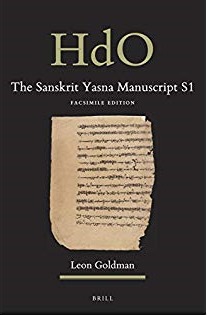Leon Goldman (2018). The Sanskrit Yasna Manuscript S1. Facsimile Edition. Handbook of Oriental Studies 32/1, Corpus Avesticum Series. Leiden–Boston, Brill.
Review by Prof Miguel Ángel Andrés-Toledo, Professor in the Departament of Near and Middle Eastern Civilization , Universit of Toronto
This book is a facsimile edition of the manuscript S1, which contains the Avestan text of the Yasna ceremony with its Sanskrit translation.
 Avestan texts were interpreted and firstly rendered into Pahlavi during the Sasanian period (AD 224–651). After the Arab conquest, this exegetical tradition remained nevertheless uninterrupted. New Pahlavi translations were produced in Iran as well as in India thereafter, but the Iranian language of culture was soon substituted by its equivalent Indian one, Sanskrit, when Zoroastrian communities moved from Iran to their new homeland. Probably as early as the 12th century AD, Parsi scholars in India rendered into Sanskrit several Avestan (Yasna; Wīsperad; Wīdēwdād; Xorde Avesta; Yašt; Aogəmadaēcā) and Pahlavi texts (Mēnōg ī xrad “The Spirit of Wisdom;” Škand gumānīg wīzār “Explanation to dispel doubts;” Ardā Wīrāz nāmag “Book of the righteous Wīrāz;” Cim ī kustīg “The significance of the sacred girdle”). The most renowned among these scholars was Nēryōsangh Dhaval, composer of the Sanskrit version of the manuscript S1, one of the oldest and most important of its type and subject of Leon Goldman’s publication.
Avestan texts were interpreted and firstly rendered into Pahlavi during the Sasanian period (AD 224–651). After the Arab conquest, this exegetical tradition remained nevertheless uninterrupted. New Pahlavi translations were produced in Iran as well as in India thereafter, but the Iranian language of culture was soon substituted by its equivalent Indian one, Sanskrit, when Zoroastrian communities moved from Iran to their new homeland. Probably as early as the 12th century AD, Parsi scholars in India rendered into Sanskrit several Avestan (Yasna; Wīsperad; Wīdēwdād; Xorde Avesta; Yašt; Aogəmadaēcā) and Pahlavi texts (Mēnōg ī xrad “The Spirit of Wisdom;” Škand gumānīg wīzār “Explanation to dispel doubts;” Ardā Wīrāz nāmag “Book of the righteous Wīrāz;” Cim ī kustīg “The significance of the sacred girdle”). The most renowned among these scholars was Nēryōsangh Dhaval, composer of the Sanskrit version of the manuscript S1, one of the oldest and most important of its type and subject of Leon Goldman’s publication.
This manuscript has a long history. Karl Friedrich Geldner (1886–1896, Prolegomena xiii), critical editor of the Avesta, was the first who called it S1, because it formerly belonged to Mobed Mancherji Barzoji Powri of Surat. It was later in possession of Dastur Kaikhusro Jamaspji, on behalf of whom Prof. A. V. W. Jackson eventually donated it to the Columbia University Library, in New York City, where it is currently preserved. Thanks to the generosity of an anonymous donor through FEZANA in memory of Shams-ul-Ulama Dastur Dr. Maneckji Nusserwanji Dhalla, former student at the Columbia University, and to the joint effort of Prof. Ehsan Yarshater and the library of this university, the manuscript S1 was restored in 2015 and could subsequently be studied.
From the point of view of its content, the text of the Yasna in S1 extends from 1.6 to 46.19, according to the standard division in Karl Friedrich Geldner’s (1886–1896) critical edition, the rest of folios containing the other passages being lost. In spite of this loss, S1 remains one of the oldest and most important witnesses of the manuscript transmission of both the Avestan and the Sanskrit versions of the Yasna. Its collation is therefore necessary for any critical edition of these texts.
Some years ago, Leon Goldman, a leading expert in the field of Avestan philology, indexed and made this manuscript available online on the Avestan Digital Archive (http://avesta-archive.com/), where scholars and general public can easily find the beginning of each passage of the Yasna in its original Avestan version, followed by its Sanskrit translation. His recent book reproduces that indexed version.
The book can be divided into three main parts:
1. introduction (pp. 1–55);
2. facsimile edition of the manuscript in colour images (pp. 57–366);
3. references (pp. 367–371).
Among some other relevant details of the introduction to the facsimile edition, I highlight Leon Goldman’s accurate insight into the Parsi Sanskrit tradition, also interesting for a general public, and the most extensive palaeographic study of a Sanskrit translation of an Avestan text so far. Especially because of the latter, his book is pioneer, and will definitely be taken as a model for further studies on this important, yet unexplored field extending between Indian and Iranian Studies.
As regards the second, largest part of the book, the facsimile edition, I would just underline that the colour images of the manuscript have been reproduced in high quality and are easily readable (obviously for those acquainted with the Avestan and/or Sanskrit languages). Although they might seem quite small at a first glance, actually the size of the pages is similar to that of the folios in the original manuscript (31 x 23 cms).
Finally, the references include the most relevant editions and studies on the Sanskrit translations up today, as well as a list of other manuscripts of the Yasna available online, some of which are counted among the same type of Avestan manuscripts with Sanskrit translation.
FEZANA must be proud of its contribution to the restoration of this manuscript. It has been verily decisive to complete a chain of knowledge that started with this valuable copy of the text of the Yasna by a Parsi scholar many centuries ago, and ended up in modern times in its exquisite facsimile publication by Leon Goldman.
Book review is courtesy of FEZANA Journal, Vol. 32, No. 2, Summer 2018.
